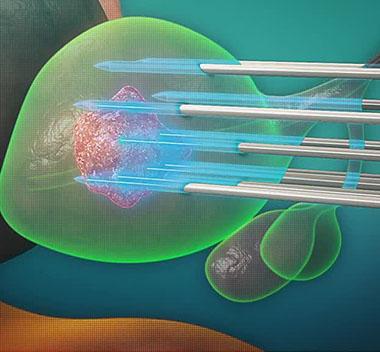Brachytherapy, also known as internal radiation therapy, is a type of radiation treatment where a radioactive source is placed directly inside or next to the area that needs treatment. For breast cancer, brachytherapy involves placing radioactive seeds, pellets or catheters in the breast tissue near the tumour site. This allows a large dose of radiation to be delivered to the tumour while limiting damage to nearby healthy breast tissue and organs.
How is it Administered?
There are two main types of brachytherapy used for breast cancer - high dose rate (HDR) and low dose rate (LDR). For HDR brachytherapy, a small radioactive source on the end of a catheter is temporarily placed in the breast and then removed once the prescribed dose is delivered. This is usually done as an outpatient procedure and treatment times can range from 15-30 minutes.
For LDR brachytherapy, also known as seed implantation, tiny radioactive seeds are permanently placed inside thin catheters in the breast near the tumour site using imaging guidance. The seeds slowly release their radiation over days or weeks before becoming harmless. Patients go home with the seeds in place and return later to have the catheters removed.
Candidate Selection and Screening
Brachytherapy is typically used for early stage invasive breast cancers or ductal carcinoma in situ (DCIS) that are smaller in size. The best candidates are those with tumors less than 3 cm, that have not spread to the lymph nodes or other parts of the body. A CT or MRI image of the breast is required to carefully evaluate tumor location and size prior to treatment planning.
Treatment Planning and Delivery
A radiation oncologist works with a medical physicist to determine optimum placement and number of catheters or seeds needed based on breast size, tumor location and goals of treatment. Treatment plans are computer generated to ensure adequate radiation dose to the tumor while avoiding overexposure to surrounding healthy tissue.
For catheter-based HDR brachytherapy, the catheters are inserted using imaging guidance in an operating room under local anesthesia on an outpatient basis. The radioactive source is then delivered through the catheters with help from an afterloader machine at preset time intervals.
For LDR seed implants, the radioactive seeds, about the size of a grain of rice, are permanently placed through the catheters using real-time ultrasound guidance to target the tumor bed perimeter. The seeds slowly release low dose radiation over weeks or months.
Benefits and Effectiveness
Some key benefits of brachytherapy for breast cancer include precision targeting of radiation dose to the tumor region, ability to deliver a high cumulative radiation dose in fewer treatments, excellent cosmetic outcomes and convenience of limited number of outpatient visits.
Several clinical studies have found brachytherapy to be as effective as whole breast external beam radiation for controlling tumor growth when used as part of breast conservation treatment for early stage disease. 5-10 year local control and survival rates comparable to surgery followed by whole breast radiation have been reported.
Side Effects and Risks
As brachytherapy delivers an intense localized dose of radiation to a confined volume of breast tissue, side effects are usually mild compared to whole breast radiation. Common temporary side effects may include skin irritation, soreness and swelling around the implantation site.
Long term or permanent risks can include fatigue, breast hardness or induration at the treatment site. There is a small risk of the seeds migrating in the breast tissue post implant. Precise treatment planning and delivery help minimize risks and side effects. Further studies are evaluating long term cosmetic results and efficacy.
Who Should Consider This Option?
Brachytherapy is ideal for select patients with early stage breast cancer who desire accelerated partial breast radiation as part of breast conservation, excellent cosmetic outcomes and limited treatment visits. It allows delivery of therapeutic radiation doses similar to lumpectomy and whole breast radiation in fewer sessions better tolerance.
Consulting a breast radiation oncologist is recommended to determine candidacy based on tumor characteristics, medical history and treatment goals. Brachytherapy provides an effective targeted alternative to whole breast radiation therapy for properly selected patients. Ongoing research continues to refine techniques and long term outcomes.
breast brachytherapy delivers concentrated radiation directly to the tumor region offering excellent tumor control and cosmetic results. As an accelerated partial breast irradiation option, it allows eligible low risk patients the benefits of breast conserving therapy with reduced treatment time and side effects. Patient selection and technologically optimized delivery are keys to achieving results comparable to standard whole breast radiation therapy.
Identify the language that you favor.
About Author:
Priya Pandey is a dynamic and passionate editor with over three years of expertise in content editing and proofreading. Holding a bachelor's degree in biotechnology, Priya has a knack for making the content engaging. Her diverse portfolio includes editing documents across different industries, including food and beverages, information and technology, healthcare, chemical and materials, etc. Priya's meticulous attention to detail and commitment to excellence make her an invaluable asset in the world of content creation and refinement.
(LinkedIn- https://www.linkedin.com/in/priya-pandey-8417a8173/)

